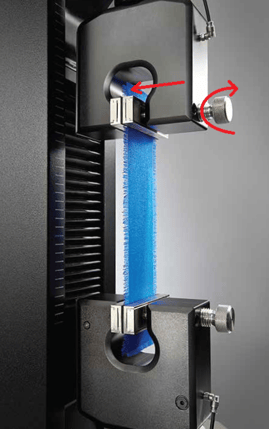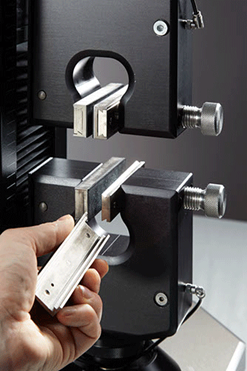Typical uses include tensile strength, tear strength and seam slippage tests.
T27 Pneumatic Grips can be used for tests up to 5000 N.
Typical uses include tensile strength, tear strength and seam slippage tests.
They can also be used in conjunction with other fixtures such as T12 and T14 for attachments and zippers.
T27 is supplied as a pair of grips, complete with 4 of 100 x 30 mm rubber jaw faces and 2 of 25 mm x 25 mm rubber jaw faces. 25 mm x 25 mm are typically used for grab tensile tests and seam tests.
The rear jaw face is pneumatically actuated while the front jaw face is static. The position of the front jaw should be adjusted using the knurled knob dependent upon the thickness of the specimen. It is important that the knurled knob on the top and bottom grips is screwed inwards to reduce the gap between the front and back jaw faces to a minimum distance, allowing just enough gap to allow placement of the specimen. If the gap is too large then slippage of the specimen may occur during testing.

To change a jaw face, simple pull and slide to the right or left, and it will be released. Slide the alternative jaw face over the dove-tail and ensure it locates correctly on the ball.

Ensure specimens are placed centrally in each of the grips. If the specimen is placed according to marks on the specimen then ensure this is the same in both top and bottom grips. There are gauge marks on the edges of the jaw faces which can help with correct alignment of most specimens.
In most cases, specimens should be "slack mounted", this means it should be suspended under its own weight and without any pretension – the application of pretension during clamping will cause problems with test results. If pretension is required in the test, Titan and TestWise will apply this automatically.
When closing the jaws to clamp (grip) the specimen, the pneumatic pressure is applied in two stages: when first closed, the pressure is low, then when the test is started, the pressure is increased to the maximum set point. The low pressure at first close is a safety feature for the protection of the operator.
If the fabric under test is sensitive to pressure and may be damaged by the high pressure of the jaws during the test, then the pressure can be reduced for this test by using the Jaw Pressure slider. This is a temporary change and the next test will revert to the default 100%.

The jaws can be opened or closed by using the:
-
Titan button – first press closes the top jaws, second press closes bottom jaw, and third press starts the test. To undo the last action for re-positioning the specimen, press and hold the Titan button for 2-3 seconds.
-
Foot-switch – works in the same manner as the Titan button but leaves both hands free to positioning specimens.
-
Hand Held Controller (Manual Controller) – this is an option accessory and can control opening and closing of the jaws in the same manner as above. The Manual Controller can also be used to position the grips or fixtures (move up and down) and in some procedures can be used to indicate when an observed "event" occurred.
-
PC Keyboard – the F2 and F3 key can be used to open or close the top and bottom jaws respectively.
-
PC Screen – click on the "Top Jaw" or "Bottom Jaw" button – clicking when showing open will close the jaws, clicking when closed will open the jaws.

At the end of the test, the T27 Pneumatic Grips will open automatically to release the specimen.

Safety Warning – for some test procedures, the gauge length (or jaw separation) can be small and the top jaws will move quickly downwards towards the bottom jaws – keep hands and fingers clear during this time until the jaws stop moving downwards.